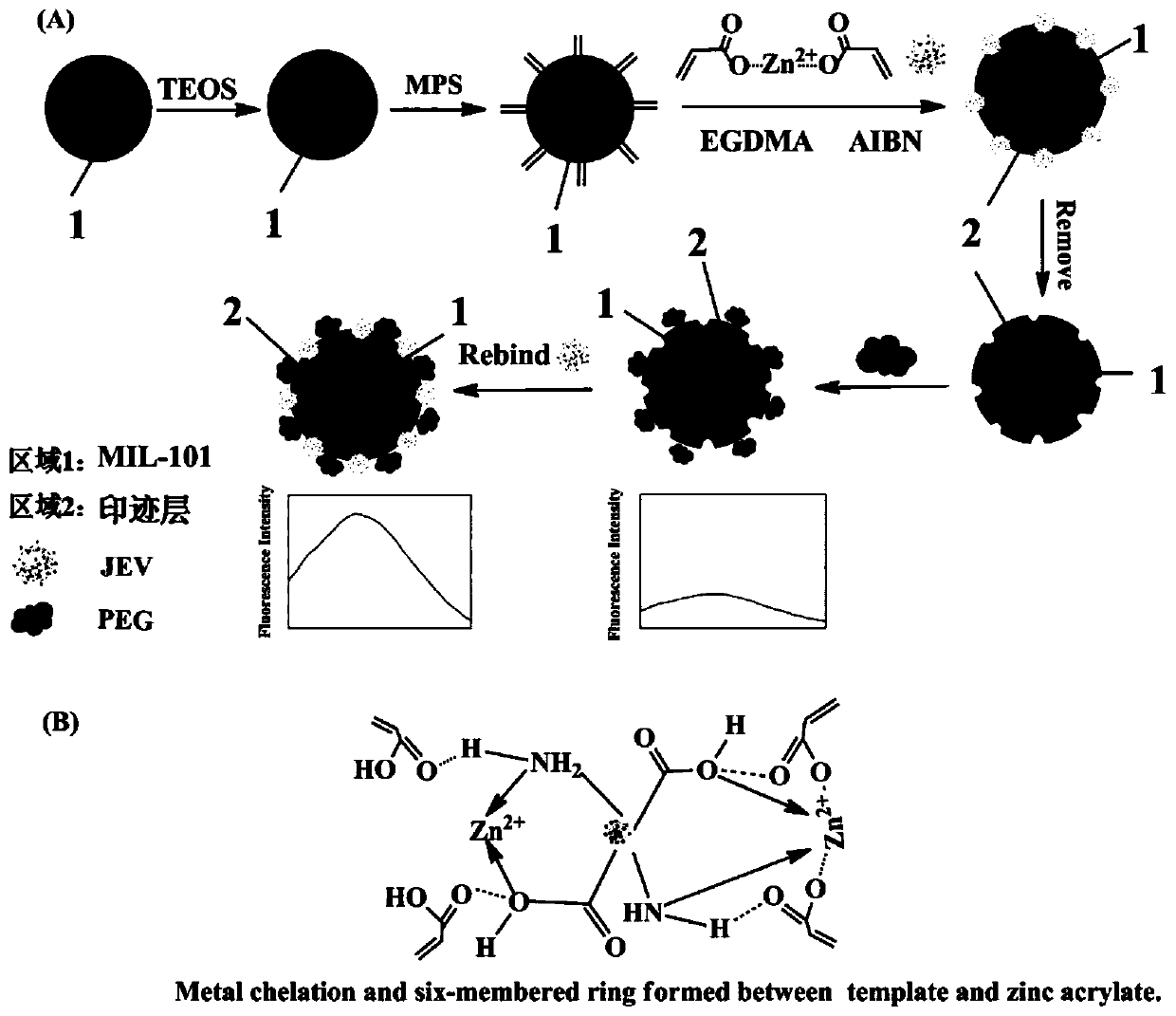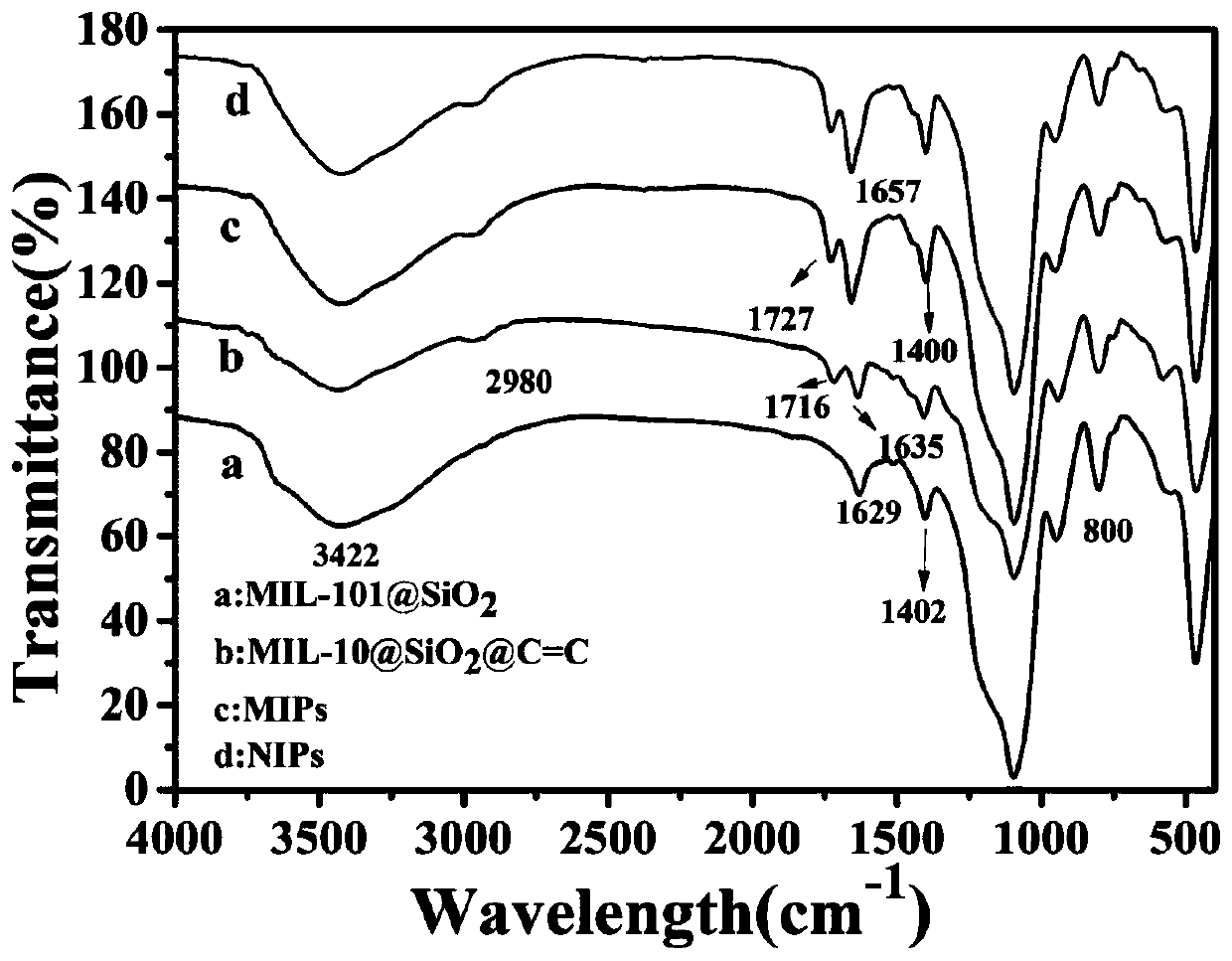Preparation and application of novel virus molecule imprinted fluorescent sensor
A fluorescent sensor and molecular imprinting technology, which is applied in the field of analytical chemical detection, can solve the problem of unsatisfactory imprinting effect and achieve the effect of improving specific recognition ability
- Summary
- Abstract
- Description
- Claims
- Application Information
AI Technical Summary
Problems solved by technology
Method used
Image
Examples
Embodiment 1
[0027] Example 1: Preparation method of a novel viral molecularly imprinted fluorescent sensor
[0028] (1) Preparation of metal-organic framework MIL-101: Cr(NO 3 ) 3 9H 2 O (2.00g), terephthalic acid (TPA, 0.82g) were mixed with sodium acetate solution, and after magnetic stirring for 30min, the solution was transferred to a polytetrafluoroethylene reactor and placed in a constant temperature blast drying oven at 200°C . After 12 hours, the sample was fully washed with ultrapure water and filtered, and then dried in a constant temperature drying oven at 50°C for 6 hours. Finally, MIL-101 was obtained by purification in a hot water bath and hot ethanol, followed by the addition of 30 mM NH 4 F and continue heating at 60°C for 3h. Finally the samples were collected by centrifugation and dried at 50 °C for 12 h.
[0029] (2) Preparation of vinylated MIL-101 (MIL-101@C=C): Mix 75mL absolute ethanol, 15mL ultrapure water and 0.1g MIL-101 for 20min, then add 2mL ammonia wate...
Embodiment 2
[0033] Example 2: Characterization of the performance, morphology and structure of the JVIPs fluorescent sensor and intermediate products.
[0034] The structure and morphology of all the prepared materials were characterized by Fourier transform infrared spectrometer, X-ray diffractometer and scanning electron microscope. figure 2 for MIL-101@SiO 2 (a), MIL-101@SiO 2 C=C(b), infrared spectra of JVIPs(c) and NIPs(d) particles. 500cm -1 The absorption peak at is attributed to the Cr-O of MIL-101 at 3400cm -1 The absorption here is produced by the water adsorbed by the material. at 1090cm -1 and 800cm -1 The absorption peak at is attributed to the asymmetric stretching vibration of Si-O-Si and the stretching vibration of Si-O. C=O and C-H(-CH in zinc acrylate 3 ) absorption peaks appear at 1716cm -1 and 2980cm -1 place. Comparing (c) and (d), it can be observed that the absorption bands of the imprinted polymer (after elution of the template) and the non-imprinted po...
Embodiment 3
[0037] Embodiment 3: the application of described JVIPs fluorescent sensor
[0038] The experimental conditions of this example are: the dosage of JVIP is 19 μg / mL, the pH is 7.5, the adsorption time is 20 min, and the temperature is 37°C. The specific implementation method is: take a specific concentration of JEV and 19 μg / mL of JVIP in PB buffer, adjust the pH of the whole system to 7.5, and measure the fluorescence intensity after shaking and adsorbing at 37°C for 20 minutes.
[0039] (1) Detection and analysis of different concentrations of JEV by JVIPs fluorescent sensor
[0040] According to the above experimental steps, the JVIPs sensor of the present invention is used to detect and analyze the JEV of different concentrations, the results are as follows Figure 5 As shown, the analytical concentration range of the prepared sensor for JEV is 0.05-1.4nM, and the detection limit is 0.1pM. The results show that the linear range is wide, the detection limit is low, and the ...
PUM
| Property | Measurement | Unit |
|---|---|---|
| Particle size | aaaaa | aaaaa |
| Size | aaaaa | aaaaa |
| Thickness | aaaaa | aaaaa |
Abstract
Description
Claims
Application Information
 Login to View More
Login to View More - R&D
- Intellectual Property
- Life Sciences
- Materials
- Tech Scout
- Unparalleled Data Quality
- Higher Quality Content
- 60% Fewer Hallucinations
Browse by: Latest US Patents, China's latest patents, Technical Efficacy Thesaurus, Application Domain, Technology Topic, Popular Technical Reports.
© 2025 PatSnap. All rights reserved.Legal|Privacy policy|Modern Slavery Act Transparency Statement|Sitemap|About US| Contact US: help@patsnap.com



